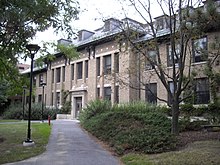New York State College of Forestry at Cornell
Louis Marshall, with a summer residence at Knollwood Club on Lower Saranac Lake, branded locomotives as "instruments of arson.[6] Nevertheless, Fernow had a 6-mile (9.7 km) long railroad spur built from Axton to Tupper Lake in order to deliver logs to the Brooklyn Cooperage Company facility.Historic charcoal kiln photo:[7] To his credit, Fernow established the first tree nursery in New York State at Axton, the site of an old lumber settlement originally called Axe-town.Smoke from the burning of brush and logging slash, along with Fernow's arrogant disposition toward landowners from nearby Saranac Lake further alienated the public.In its findings, the commission concluded that "the college has exceeded the original intention of the State when the tract was granted the university for conducting silvicultural experiments.Some say that history has proven him wrong, but his opinion did have an effect: for a time, it discouraged commercial interests from prospecting for timber in the Alaskan forests.In his statement, Governor Odell said: "The operations of the College of Forestry have been subjected to grave criticism, as they have practically denuded the forest lands of the State without compensating benefits.I deem it wise therefore to withhold approval of this item until a more scientific and more reasonable method is pursued in the forestry of the lands now under the control of Cornell University.In fact, on that night in May 1903 when the telegram arrived announcing Governor Odell's veto of the annual appropriation for the College of Forestry, Bailey and Fernow were together at a dance.However, Cornell's Board of Trustees and President Schurman (despite Bailey's urgings to the contrary) decided to close the doors of the Forestry College.[16] Meanwhile, in Albany, Senator Ed Stewart of Ithaca introduced a bill drafted by Liberty Hyde Bailey, establishing the New York State College of Agriculture at Cornell.This request granted, he spoke at the hearing but the chairman and other legislators were insufficiently attentive to him, the Chancellor broke off in a fury and left the room,"before he had adduced a single coherent argument."Dean Bailey, later put up a picture of Chancellor Day, in his office, with the subscription: "Founder of the New York State College of Agriculture at Cornell."[17] The announcement of the final passage and signing of the bill, in Albany, creating the New York State College of Agriculture at Cornell was met with bonfires and the pealing of church bells in Ithaca.At the conclusion of the case, constitutional lawyer Louis Marshall stated, "I hold before me the decision in the case of the People against the Brooklyn Cooperage Company.....the consequence of that was that this 'tremendous' tract of thirty thousand acres was to be cut down 'flat' from one end of it to the other, in order that the scientific foresters might start a new forest which might mature a hundred years from the time that that contract was entered into.[34][35] Following in the footsteps of the great botanist and horticulturist, Liberty Hyde Bailey, a most extraordinary plant physiologist, Frederick Campion Steward, arrived to teach and conduct research at Cornell University in 1950, as Professor of Botany.


History of the New York State College of Forestrystatutory collegeCornell UniversityBernhard FernowWilliam F. FoxFrank S. BlackJacob Gould SchurmanAdirondack Forest PreserveBernhard E. FernowU.S. Forest Serviceclearcuttinglogging slashLouis MarshallKnollwood ClubLower Saranac Lakemethanolcharcoaldestructive distillationnorway spruceClarence PettyE.H. HarrimanLouis Agassiz FuertesJournal of ForestryPeople v. the Brooklyn Cooperage CompanyBenjamin B. Odellpocket vetoRalph C. BryantRaphael ZonNew York State College of AgricultureMorrill ActLiberty Hyde BaileyJames R. DayEzra CornellPenn StateUniversity of TorontoJoseph RothrockPenn State Mont AltoFernow HallNew York State College of ForestrySyracuse UniversityBoard of Regentscooperative extensionNew York State College of Agriculture at Cornell UniversityWalter MulfordRalph HosmerYale School of ForestryGifford PinchotCornell Lab of OrnithologyArthur A. AllenEstevan Antonio FuertesJohn James AudubonHortoriumbotanisthorticulturistplant physiologistFrederick Campion StewardBoyce Thompson Institute for Plant Researchresearch forestLake PlacidCornell Botanic Gardensmineral rightsHubbard Brook Experimental ForestAtkinson Center for a Sustainable FuturesustainableHistory of Cornell UniversityState University of New York College of Environmental Science and ForestryFrançois André MichauxTerra pretaSyracuse University PressAstronomy Picture of the DayWayback MachineAgriculture and Life SciencesArchitecture, Art, and PlanningArts and SciencesEngineeringHotel AdministrationHuman EcologyIndustrial and Labor RelationsBusinessGraduateMedicalSciencesTri-InstitutionalPublic AdministrationVeterinaryComputing and Information ScienceAthleticsBaseballMen's basketballWomen's basketballFootballMen's ice hockeyWomen's ice hockeyMen's lacrosseMen's soccerMen's squashWrestlingBarton HallBerman FieldHoy FieldJones Golf CourseLynah RinkNewman ArenaSchoellkopf FieldAll Sports CompetitionGive My Regards to DavyHarvard (hockey) rivalryTouchdown (mascot)CentralBuildingsA.D. White HouseArboretumArt MuseumBailey HallBalch HallBarnes HallBotanic GardensBradfield HallBrain CollectionCaldwell HallCenter for Advanced ComputingComputing and Communications CenterComstock HallFuertes ObservatoryLibrariesLlenroc